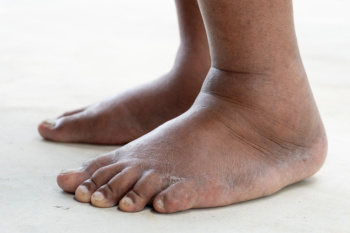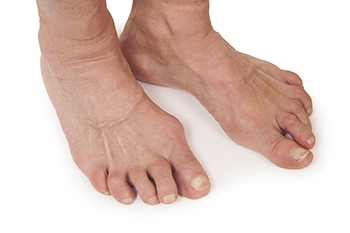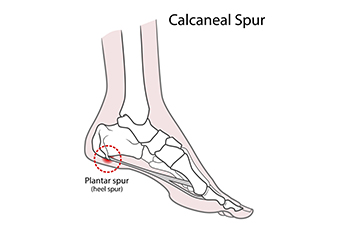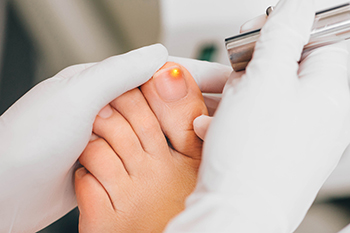Blog
Items filtered by date: September 2025
Risks and Causes of Swollen Feet and Ankles

Swelling in the feet and ankles, known as peripheral edema, develops when fluid collects in the soft tissues of the lower limbs. This is often the result of gravity, which pulls fluid downward, making the feet and ankles more prone to noticeable swelling. Common causes of swollen feet and ankles include standing or sitting for long periods and carrying excess body weight, which places added pressure on circulation. Injuries or infections involving the foot or ankle often result in localized swelling due to increased blood flow. In some cases, more serious conditions like venous insufficiency, lymphedema, or a blood clot may impair blood flow and lead to persistent swelling. Hormonal changes, as well as issues with the liver, kidneys, or heart, can also contribute. A podiatrist can help determine the source of the swelling through examination and testing. If swollen feet and ankles are affecting your daily activities, it is suggested that you make an appointment with a podiatrist for an exam, diagnosis, and appropriate treatment.
Swollen feet can be a sign of an underlying condition. If you have any concerns, contact Akena Wannamaker, DPM of ASW Foot and Ankle. Our doctor can provide the care you need to keep you pain-free and on your feet.
Swollen feet are a common ailment among pregnant women and people who stand or sit for extended periods. Aging may increase the possibility of swollen feet and patients who are obese often notice when their feet are swelling too. There may be medical reasons why swollen feet occur:
- Phlebitis - A condition that causes the veins to become inflamed and can also cause leg pain.
- Liver disease - This may lead to low blood levels of albumin which is a protein. This can cause fluid in the blood to pass into the tissues and several areas of the body can become swollen.
- Heart failure - When the heart doesn’t pump properly the blood that is normally pumped back to the heart can pool in the veins of the legs causing swollen feet.
- Kidney disease - One of the main functions of the kidneys is releasing excess fluid in the body. This type of condition can make it difficult for the kidneys to function properly, and as a result the feet may become swollen.
- Deep-vein thrombosis (DVT)- This is a serious condition where blood clots form in the veins of the legs. They can block the return of blood from the legs to the heart which may cause the feet to swell. It is important to be treated by a podiatrist if this condition is present.
Swollen feet can also be caused by bone and tendon conditions, including fractures, arthritis, and tendinitis. Additionally, there may be skin and toenail conditions and an infection may cause the feet to swell. Patients who take medicine to treat high blood pressure may be prone to getting swollen feet.
Many patients elevate their feet to help relieve the swelling and this is generally a temporary remedy. When a podiatrist is consulted the reason behind the swelling can be uncovered and subsequently treated.
If you have any questions please contact our office located in Richmond, VA . We offer the newest diagnostic and treatment technologies for all your foot and ankle needs.
Get Proper Treatment for Ankle Injuries
Learning to Manage Rheumatoid Arthritis Affecting the Feet

Rheumatoid arthritis can significantly impact the feet and cause pain, swelling, and stiffness that can interfere with daily life. Education plays an important role in helping individuals manage these challenges effectively. Learning how the disease affects joints allows patients to better understand flare-ups and long-term changes. Wearing proper footwear with supportive cushioning can reduce pressure on tender joints, while custom orthotics may provide additional relief. Low-impact exercises such as swimming or cycling are often encouraged to maintain mobility without putting stress on the feet. Regular monitoring by a podiatrist can help detect changes early and prevent deformities from worsening. Self-care strategies such as warm soaks or gentle stretching may also ease discomfort. If rheumatoid arthritis is affecting your feet, it is suggested that you consult a podiatrist to explore supportive treatment options and provide further guidance on this condition.
Because RA affects more than just your joints, including the joints in your feet and ankles, it is important to seek early diagnosis from your podiatrist if you feel like the pain in your feet might be caused by RA. For more information, contact Akena Wannamaker, DPM of ASW Foot and Ankle. Our doctor will assist you with all of your podiatric concerns.
What Is Rheumatoid Arthritis?
Rheumatoid Arthritis (RA) is an autoimmune disorder in which the body’s own immune system attacks the membranes surrounding the joints. Inflammation of the lining and eventually the destruction of the joint’s cartilage and bone occur, causing severe pain and immobility.
Rheumatoid Arthritis of the Feet
Although RA usually attacks multiple bones and joints throughout the entire body, almost 90 percent of cases result in pain in the foot or ankle area.
Symptoms
- Swelling and pain in the feet
- Stiffness in the feet
- Pain on the ball or sole of feet
- Joint shift and deformation
Diagnosis
Quick diagnosis of RA in the feet is important so that the podiatrist can treat the area effectively. Your doctor will ask you about your medical history, occupation, and lifestyle to determine the origin of the condition. Rheumatoid Factor tests help to determine if someone is affected by the disease.
If you have any questions, please feel free to contact our office located in Richmond, VA . We offer the newest diagnostic and treatment technologies for all your foot care needs.
Consequences of Stiffness in the Big Toe

Stiffness in the big toe, often linked to a condition called hallux limitus, can greatly interfere with normal foot function. The big toe joint plays an important role in walking, balance, and push-off during each step. When motion at the joint is reduced, it can cause pain on the top of the toe and limit the ability to bend it properly. Over time, this stiffness may lead to bone spurs forming around the joint, further restricting movement and contributing to swelling or discomfort in shoes. In more advanced cases, the joint may become rigid, a condition known as hallux rigidus, which can cause ongoing pain and difficulty with everyday activities. A podiatrist can evaluate stiffness in the big toe and recommend treatment options to restore mobility, relieve pain, and protect long-term joint health. If you notice stiffness in your big toe, it is suggested that you schedule an appointment with a podiatrist for an evaluation and appropriate treatment.
Toe pain can disrupt your daily activities. If you have any concerns, contact Akena Wannamaker, DPM of ASW Foot and Ankle. Our doctor can provide the care you need to keep you pain-free and on your feet.
What Causes Toe Pain?
Most severe toe pain is caused due to a sports injury, trauma from dropping something heavy on the toe, or bumping into something rigid. Other problems can develop over time for various reasons.
Toe pain can be caused by one or more ailments. The most common include:
- Trauma
- Sports injury
- Wearing shoes that are too tight
- Arthritis
- Gout
- Corns and calluses
- Hammertoe
- Bunions
- Blisters
- Ingrown toenails
- Sprains
- Fractures (broken bones)
- Dislocations
When to See a Podiatrist
- Severe pain
- Persistent pain that lasts more than a week
- Signs of infection
- Continued swelling
- Pain that prevents walking
Diagnosis
In many cases the cause of toe pain is obvious, but in others, a podiatrist may want to use more advanced methods to determine the problem. These can range from simple visual inspections and sensation tests to X-rays and MRI scans. Prior medical history, family medical history, and any recent physical traumatic events will all be taken into consideration for a proper diagnosis.
Treatment
Treatments for toe pain and injuries vary and may include shoe inserts, padding, taping, medicines, injections, and in some cases, surgery. If you believe that you have broken a toe, please see a podiatrist as soon as possible.
If you have any questions please contact our office located in Richmond, VA . We offer the newest diagnostic and treatment technologies for all your foot and ankle needs.
Evaluating Treatment Paths for Painful Heel Growths

Bony projections that form beneath the heel can sometimes be an incidental finding, but in other cases they contribute to ongoing discomfort. When symptoms arise, the focus is often on calming the irritation in nearby tissues rather than the growth itself. Soft, shock-absorbing shoes or inserts may reduce impact, while gentle stretching routines help ease tension in the arch and calf. More advanced measures, such as specialized therapy or procedures, may be considered if pain continues, despite these adjustments. Surgical removal of a heel spur is generally a final step, reserved for cases that resist other care options. The most effective plan takes into account the cause of pain, activity demands, and overall foot condition. If discomfort near the heel becomes persistent, it is suggested that you see a podiatrist for an assessment and appropriate treatment.
Heel spurs can be incredibly painful and sometimes may make you unable to participate in physical activities. To get medical care for your heel spurs, contact Akena Wannamaker, DPM from ASW Foot and Ankle. Our doctor will do everything possible to treat your condition.
Heels Spurs
Heel spurs are formed by calcium deposits on the back of the foot where the heel is. This can also be caused by small fragments of bone breaking off one section of the foot, attaching onto the back of the foot. Heel spurs can also be bone growth on the back of the foot and may grow in the direction of the arch of the foot.
Older individuals usually suffer from heel spurs and pain sometimes intensifies with age. One of the main condition's spurs are related to is plantar fasciitis.
Pain
The pain associated with spurs is often because of weight placed on the feet. When someone is walking, their entire weight is concentrated on the feet. Bone spurs then have the tendency to affect other bones and tissues around the foot. As the pain continues, the feet will become tender and sensitive over time.
Treatments
There are many ways to treat heel spurs. If one is suffering from heel spurs in conjunction with pain, there are several methods for healing. Medication, surgery, and herbal care are some options.
If you have any questions, please feel free to contact our office located in Richmond, VA . We offer the newest diagnostic and treatment technologies for all your foot care needs.
Understanding Types of Toenail Fungus and Treatment

Toenail fungus, also known as onychomycosis, can appear in several forms, each requiring careful treatment. The most common is distal subungual onychomycosis, which starts at the tip of the nail and spreads underneath, often treated with oral antifungal medications. White superficial onychomycosis affects the top layer of the nail, creating chalky white spots that can sometimes be managed with topical antifungal creams. Proximal subungual onychomycosis begins at the base of the nail and moves outward, and is more common in people with a weakened immune system. Treatment usually includes prescription antifungal therapy. Candida onychomycosis is caused by yeast rather than dermatophytes and can make nails thick, discolored, and painful, often requiring both oral and topical antifungals. Since toenail fungus can worsen if untreated, it is suggested that you visit a podiatrist to ensure an accurate diagnosis and obtain the most effective treatment for restoring healthy nails.
If left untreated, toenail fungus may spread to other toenails, skin, or even fingernails. If you suspect you have toenail fungus it is important to seek treatment right away. For more information about treatment, contact Akena Wannamaker, DPM of ASW Foot and Ankle. Our doctor can provide the care you need to keep you pain-free and on your feet.
Symptoms
- Warped or oddly shaped nails
- Yellowish nails
- Loose/separated nail
- Buildup of bits and pieces of nail fragments under the nail
- Brittle, broken, thickened nail
Treatment
If self-care strategies and over-the-counter medications does not help your fungus, your podiatrist may give you a prescription drug instead. Even if you find relief from your toenail fungus symptoms, you may experience a repeat infection in the future.
Prevention
In order to prevent getting toenail fungus in the future, you should always make sure to wash your feet with soap and water. After washing, it is important to dry your feet thoroughly especially in between the toes. When trimming your toenails, be sure to trim straight across instead of in a rounded shape. It is crucial not to cover up discolored nails with nail polish because that will prevent your nail from being able to “breathe”.
In some cases, surgical procedure may be needed to remove the toenail fungus. Consult with your podiatrist about the best treatment options for your case of toenail fungus.
If you have any questions please contact our office located in Richmond, VA . We offer the newest diagnostic and treatment technologies for all your foot and ankle needs.

